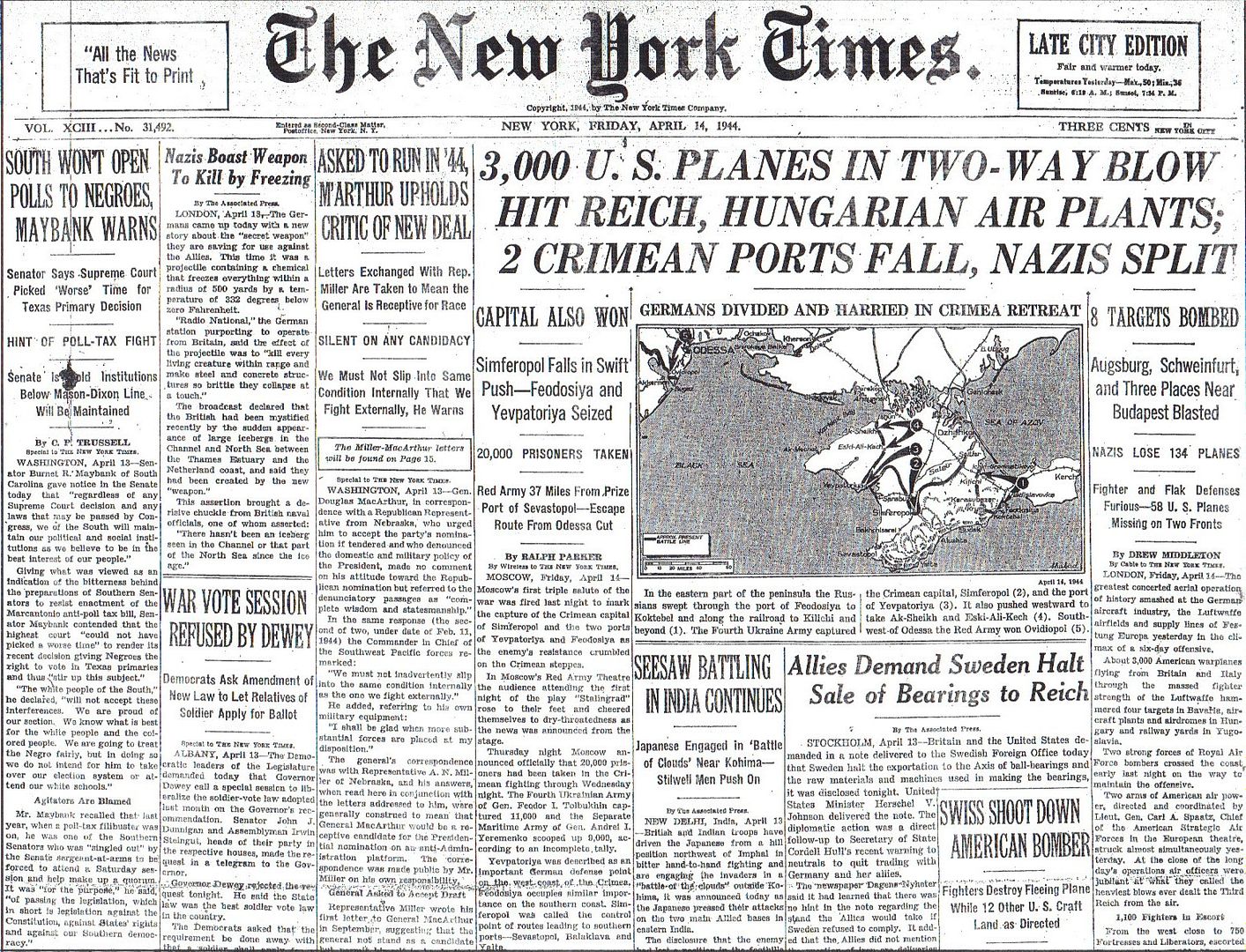
Posted on 04/14/2014 6:08:57 AM PDT by Homer_J_Simpson

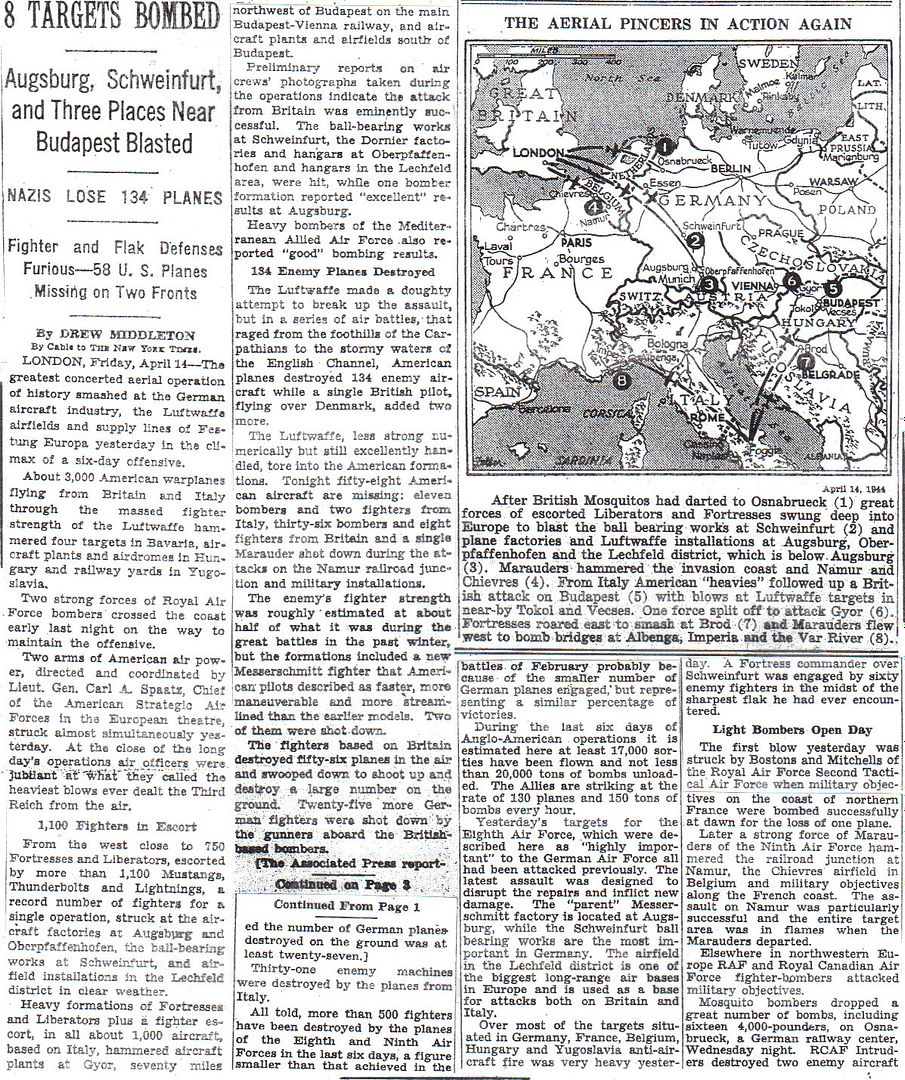
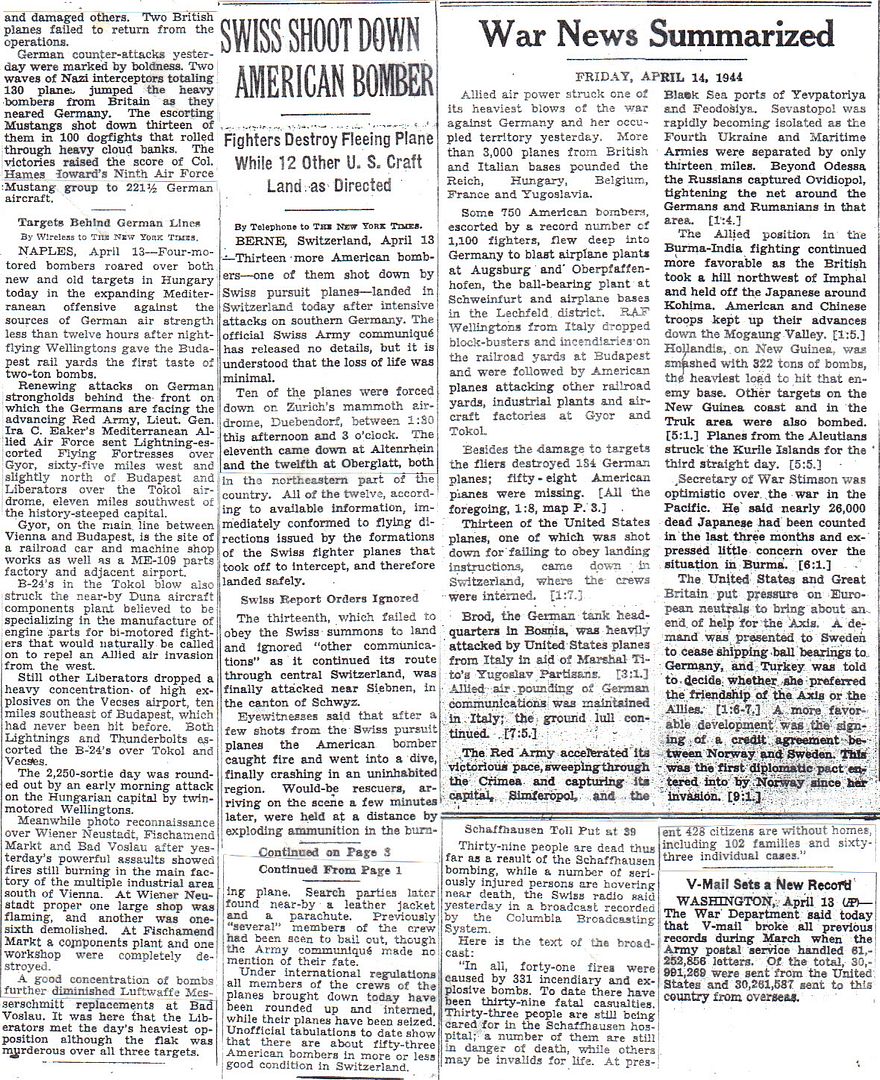
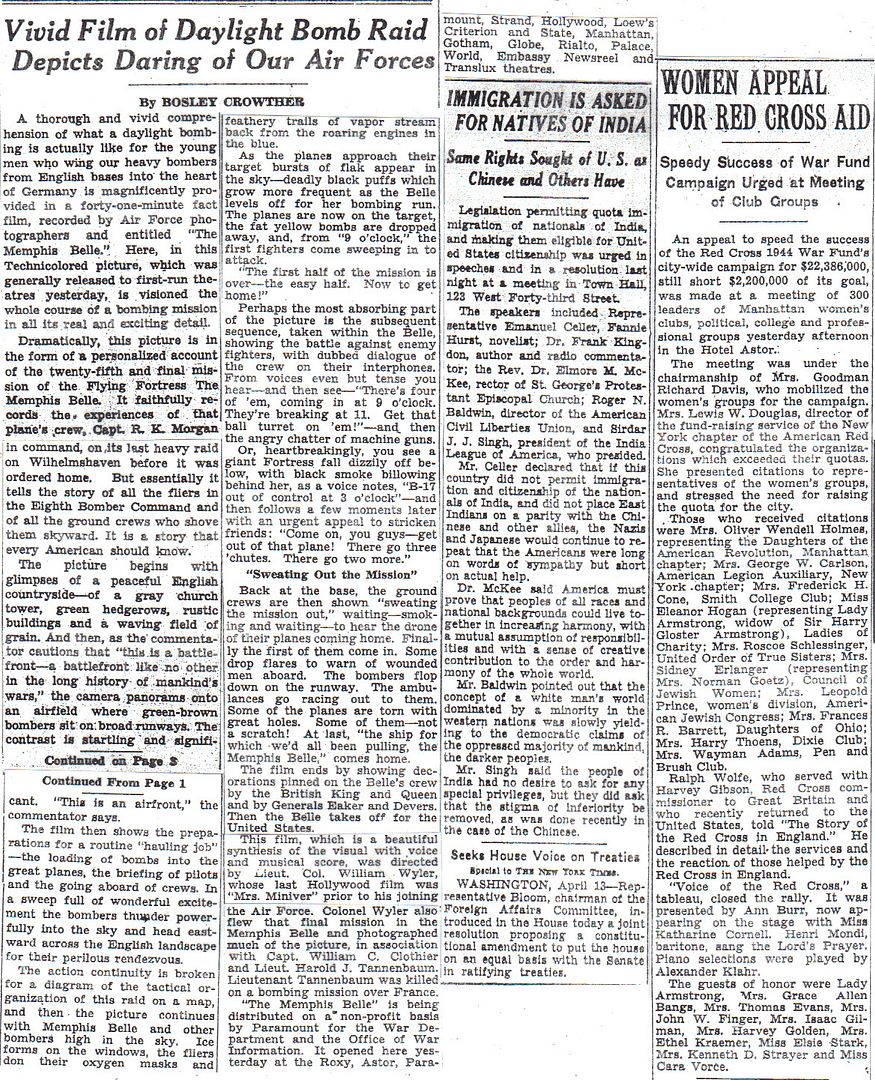
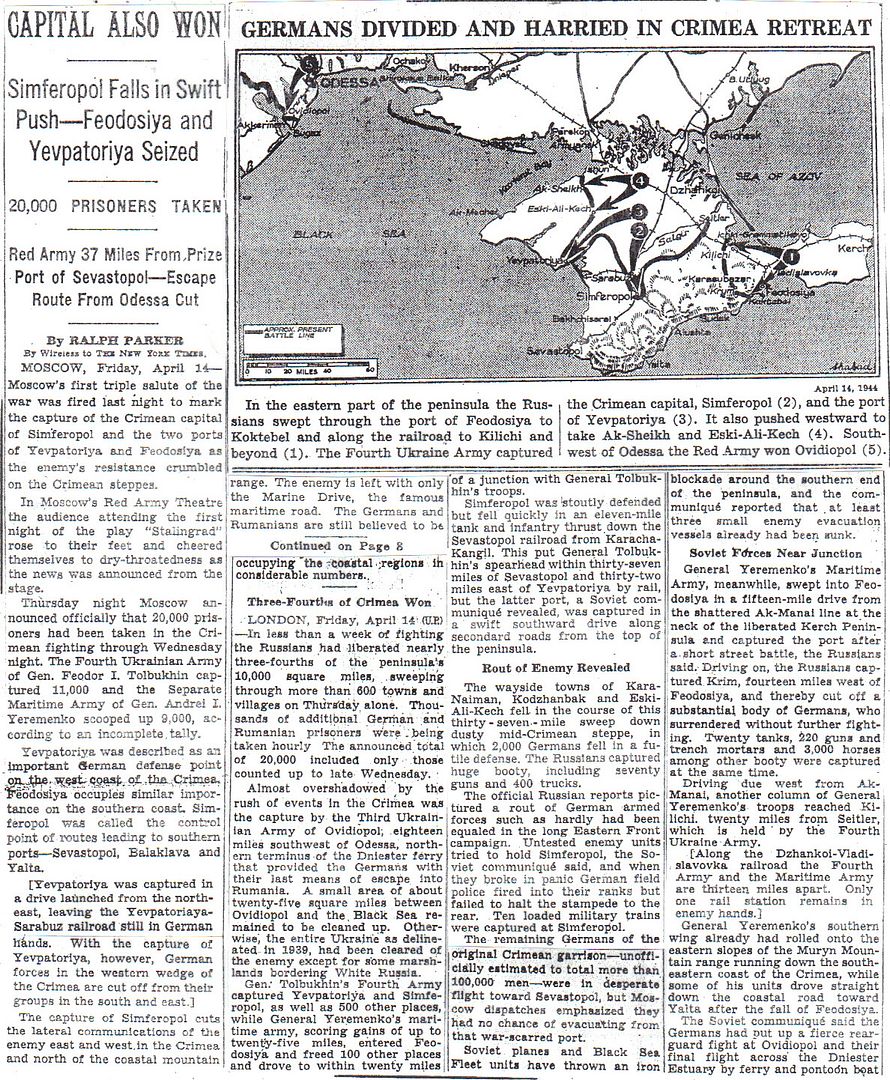
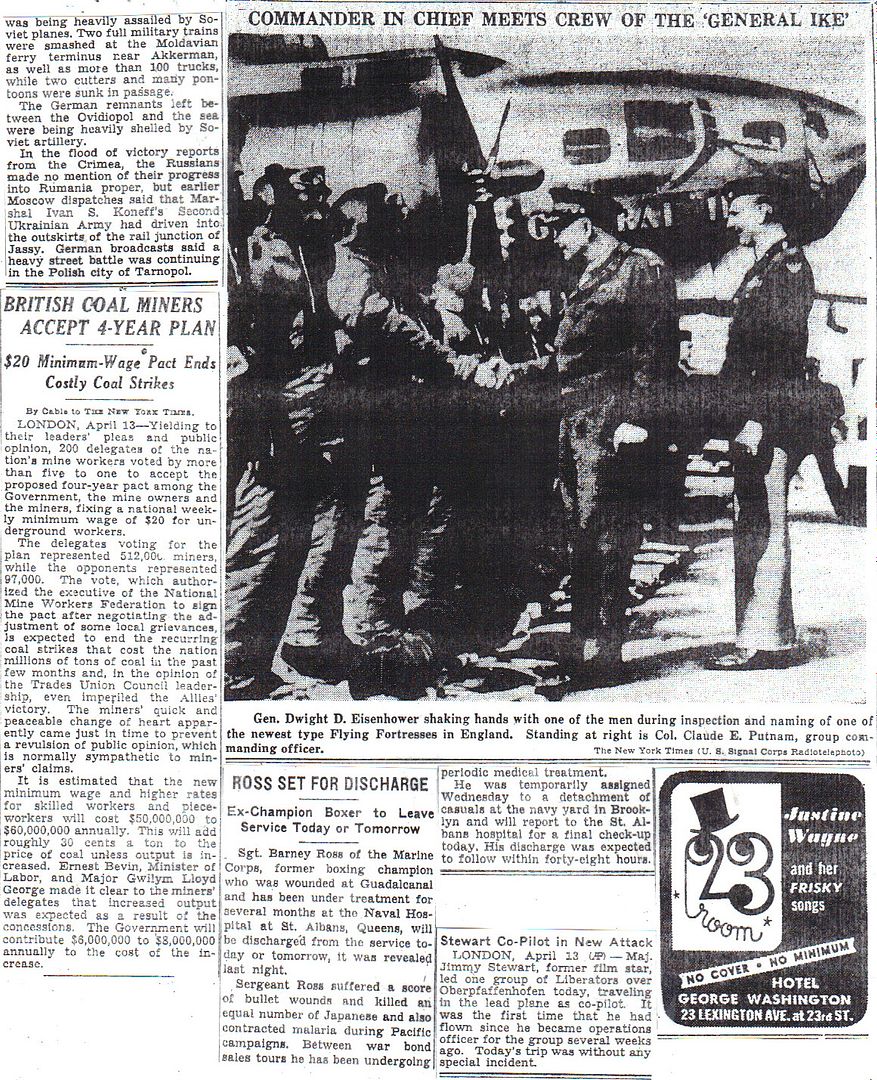
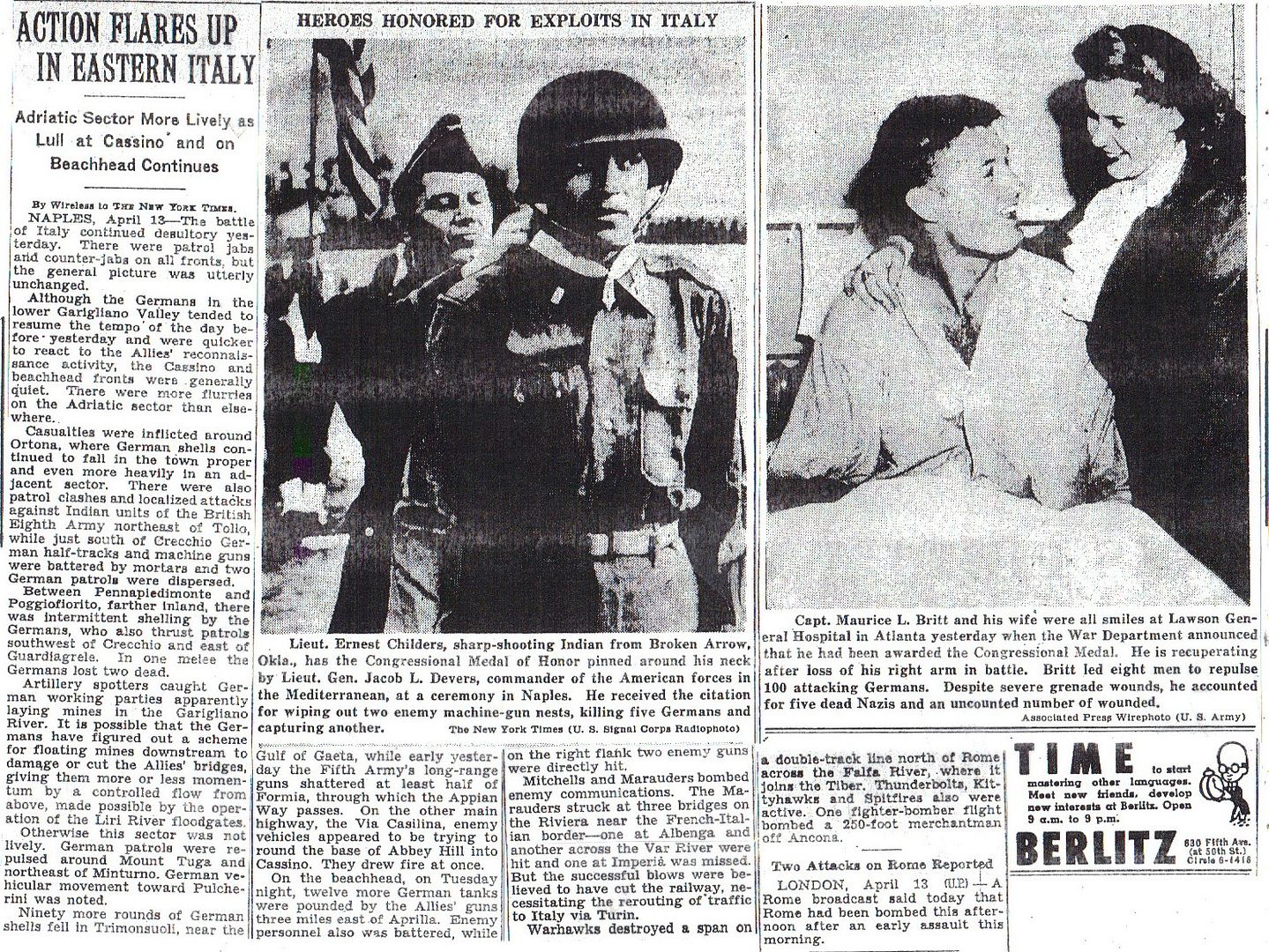
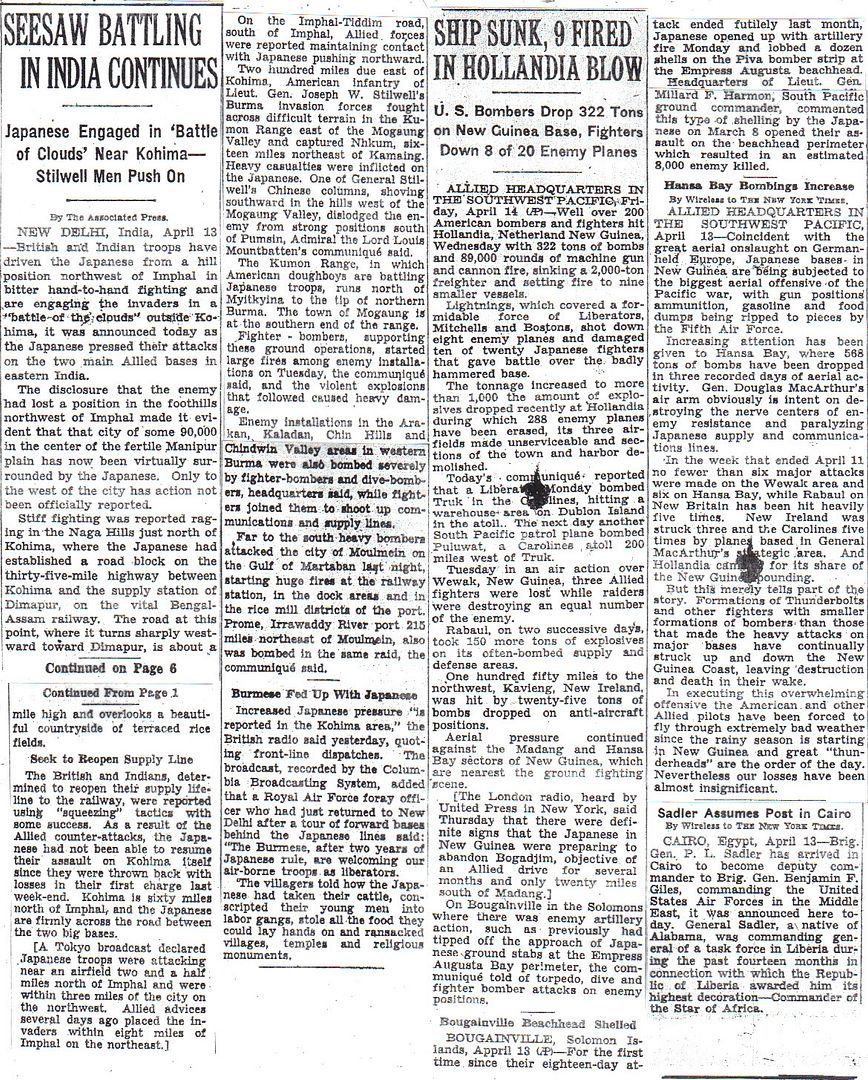

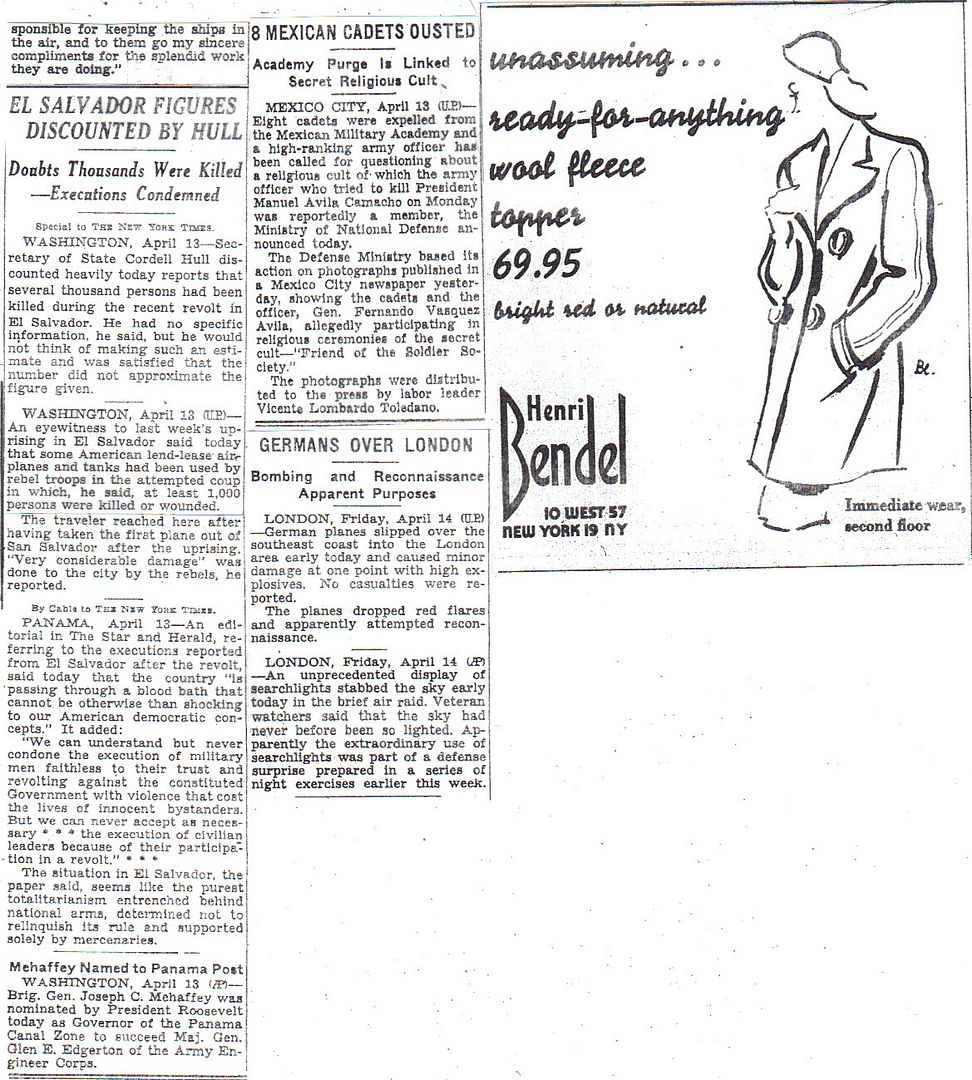
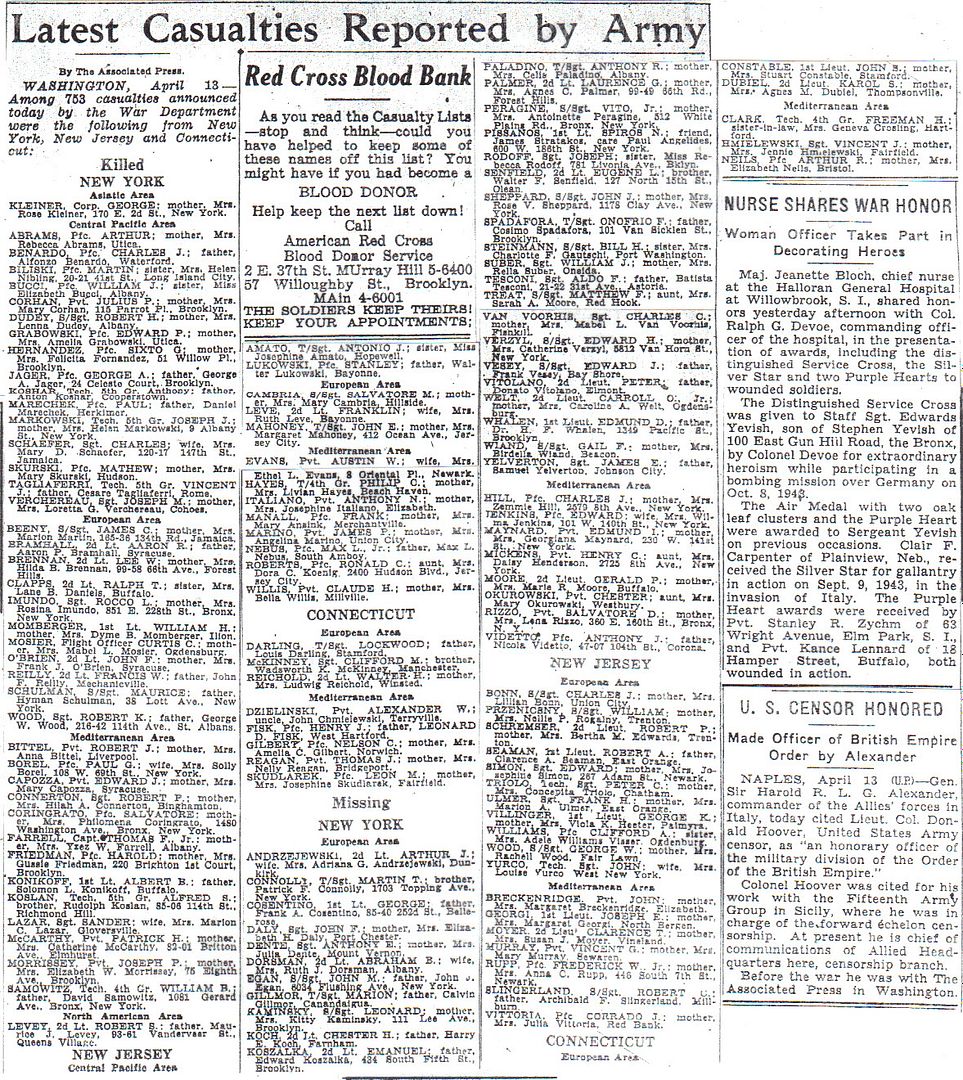

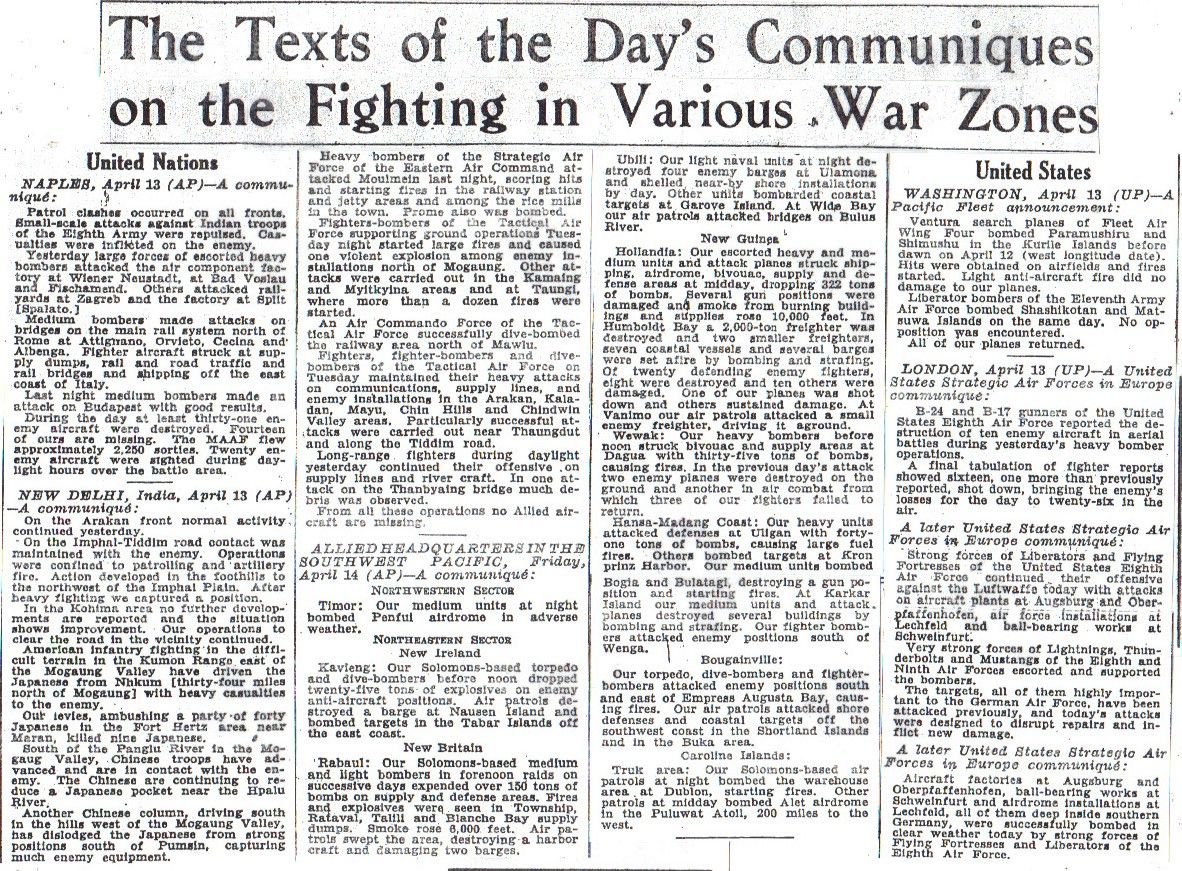
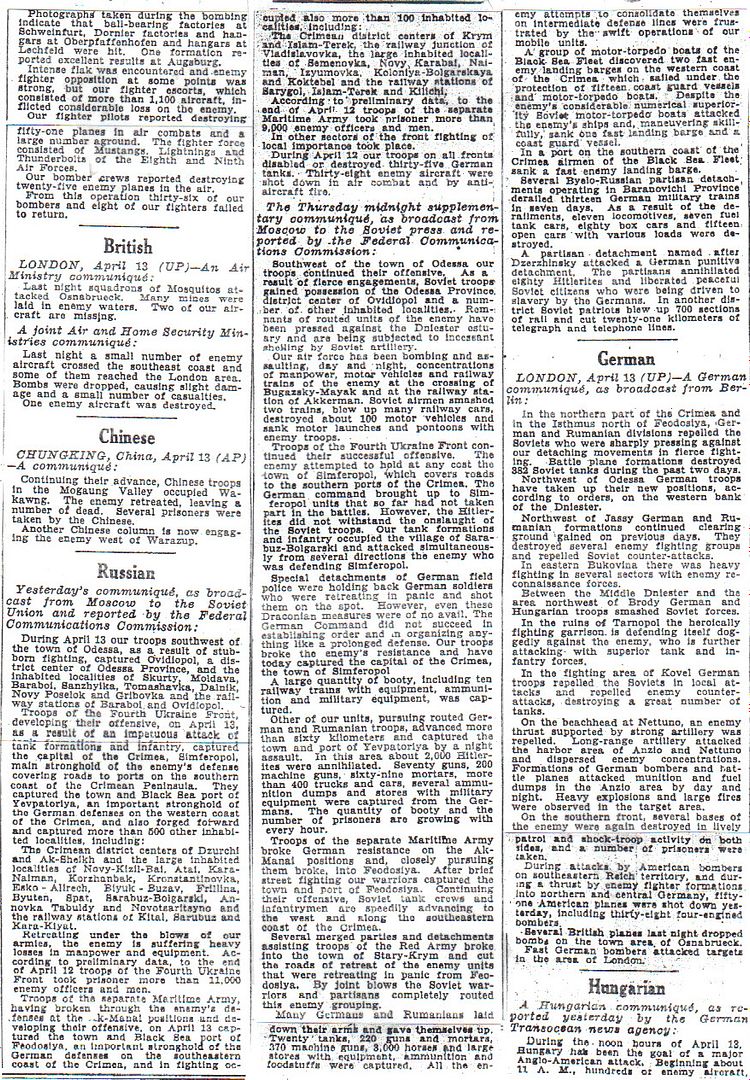
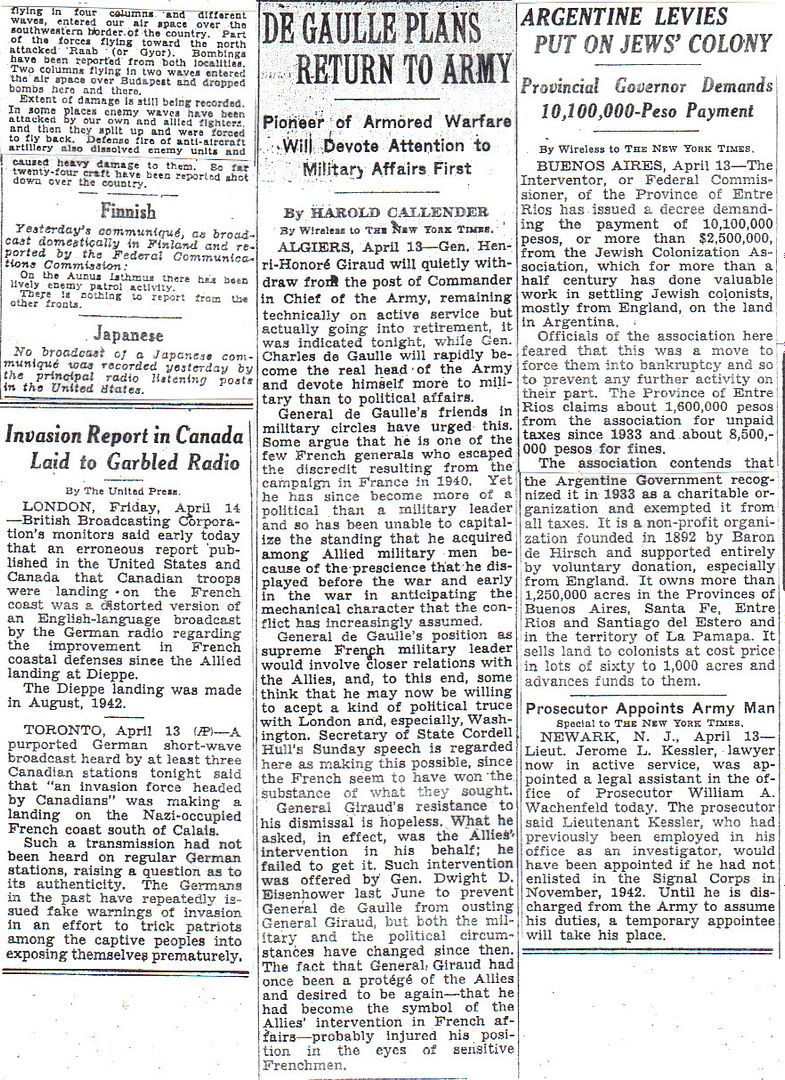
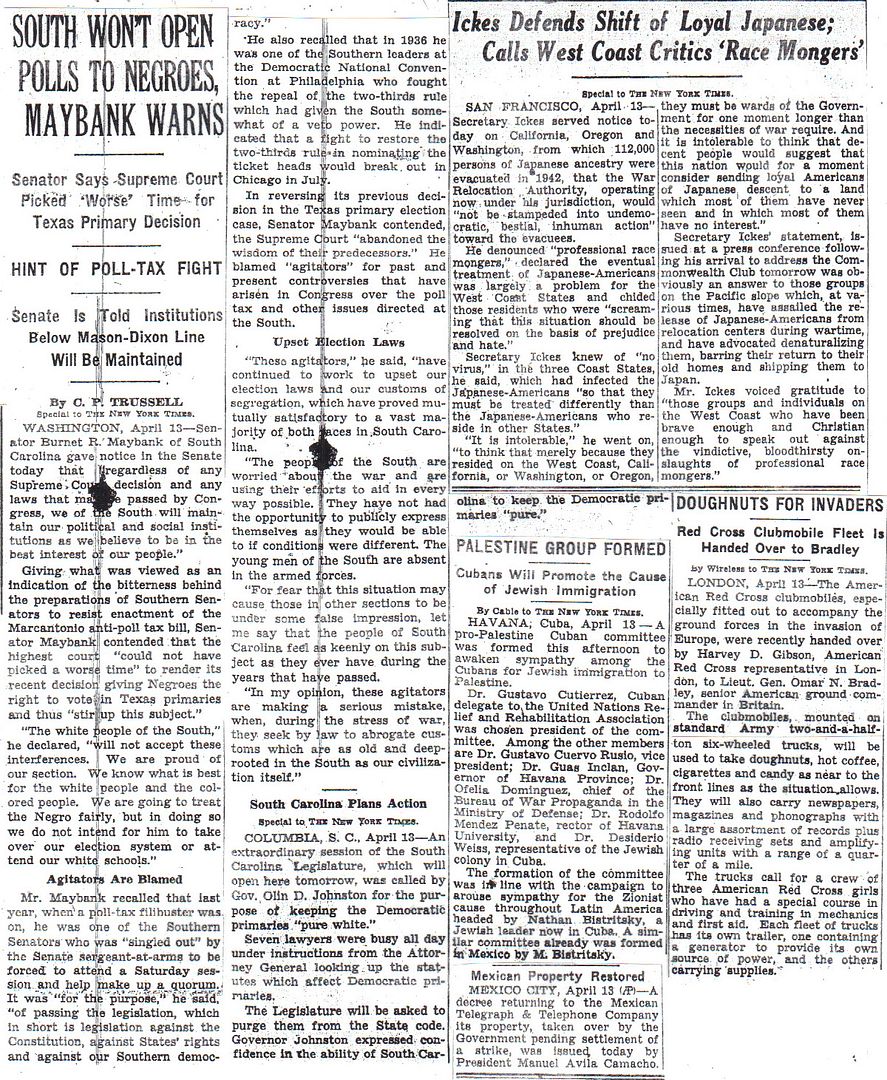
* Bosley Crowther makes a rare appearance on the news thread today with his review of the newly released film “The Memphis Belle.” This is the documentary that presumably inspired the 1990 fictionalized movie of the same name. Youtube has the whole 41 ½ minute film. Link below. If you want the full screen version you can get it on DVD from Netflix.
http://www.onwar.com/chrono/1944/apr44/14apr44.htm#
Bombay rocked by ship explosion
Friday, April 14, 1944 www.onwar.com
Fort Stikine [photo at link]
In India... The transport ship Fort Stikine, carrying explosives and cotton bales, catches fire and explodes in the Bombay Docks. A total of 27 ships are wrecked in the harbor, about 740 people are killed or missing and 476 servicemen and about 1000 civilians are injured. (In the following six months, some 10,000 troops and civilians remove one million tons of rubble from the area.)
On the Eastern Front... Both the Soviet 1st Ukrainian Front and 2nd Ukrainian Front reach the Carpathian foothills — creating a gap between the defenses of German Army Group North Ukraine and Army Group South Ukraine.
In the Soviet Union... General Nikolai F. Vatutin, the former commander of the Soviet 1st Ukrainian Front, dies of wounds received in a partisan ambush, by Ukrainian nationalists, on February 29, 1944.
In Burma... British forces break through the Japanese road block at Zubza and the British 161st Brigade at Jotsoma is relieved by attacks of other elements of the 2nd Indian Division.
In Algiers... Free French General Giraud is placed on the retired list.
http://www.etherit.co.uk/month/thismonth/14.htm
April 14th, 1944 (FRIDAY)
UNITED KINGDOM: DeGaulle retires Free French General Giraud.
U.S.S.R.: Kiev: General Nikolai F Vatutin, injured on 29 February, dies of his wounds.
Moscow: The Red Army has re-conquered the Crimea in a lightning campaign which lasted just six days. Only the southern tip around Sevastopol is holding against Marshal Tolbukhin’s Fourth Ukrainian Front. The attack was launched following the liberation of the Black Sea port of Odessa from which the Germans supplied General Jaenecke’s 17th Army in the Crimea.
Tolbukhin’s men stormed across the Perekop peninsula in the north, outflanking defences by crossing the Sivash lagoon, thus unlocking the northern gate of the Crimea. General Eremenko then came in by the side door, attacking from his toehold at Kerch in the east.
Since then the Russians have rolled up the Germans, who, under Hitler’s orders, tried to hold a second line of defence south of Perekop instead of giving ground as Jaenecke wanted to do.
Now the Germans and their Romanian allies have no choice. They have to fall back on the “Gneisenau Line” covering Sevastopol. Thousands of German and Romanian non-combatant personnel and Russian auxiliaries are being evacuated from the Crimea to Constanta. Jaenecke wants to get his fighting men away before they are trapped, but Hitler has ordered that Sevastopol must be held at all costs.
That cost will be high. Moscow radio today broadcast this order: “Sailors and airmen. Don’t allow them to escape! Destroy their ships! Shoot down their planes! Don’t allow a single enemy to escape retribution!”
ITALY: Twelfth Air Force B-25s attack Viterbo Airfield and Leghorn marshalling yard, B-26 Marauders strike at Poggibonsi, Certaldo, Cecina and Magra, attacking mostly rail facilities and hit Arezzo bridge and viaduct and Bucine viaducts; fighter-bombers also concentrate on rail lines and bridges and hit many supply dumps, gun positions and factories, generally located northeast of Rome. (Jack McKillop)
INDIA: Bombay: The merchant ship Fort Stikine catches fire while at No. 1 berth, in the early stages of cargo discharge. From a sister-ship Fort Crevier, berthed 400 yards away, smoke is seen spiralling from the Fort Stikine’s ventilators. Later it is also seen by the steamer Iran, and also by an inspector from the dock police. On a Norwegian ship, the Belray, Able Seaman Roy Haywood, going below noticed what looked like a wisp of smoke coming from a ventilator on the Fort Stikine. To no one did it occur that the ship might be on fire, and it was not reported. Some time later the fire was seen by returning stevedores. The stevedores scrambled up from the hold shouting “Fire!”
Men from a Bombay fire brigade pump on the quay promptly ran with their hoses to the ship. Not until their section leader was on board however did he remember that, for a fire in a ship carrying explosives, his instructions were to send an immediate No.2 alarm which would call out a larger force. With orders to dial 290, his sub-leader struggled back down the gangway, crowded with dock workers pushing to get ashore, and dashed to a telephone. But the telephone had no dial. Confused, he ran along the dockside, broke the glass of a fire alarm and rang the bell. Thus the fire brigade control room received only a normal call for two pumps. The hands of the harbour clock tower stood at 2.16.
In the previous five years there had been over 60 fires in ships in Bombay, but only one vessel had been lost, although 15 had carried explosives.
Because of the stink from the fish manure, the master of the Fort Stikine, Captain A.J. Naismith had told the dockers at Bombay to unload the fish first. When the fire broke out among the cotton bales they still had 6,000 cubic feet of timber on top of them. Above the timber the upper part of No.2 hold was packed with explosives. Below the cotton lay a thick layer of ammunition.
Eight minutes after receiving the alarm the fire station officer arrived with two pumps. He sent an immediate No.2 call to the control room. Eight more pumps and an emergency tender turned out. At 2.35 p.m. Norman Coombs, chief of the Bombay fire brigade, arrived dressed in slacks and jacket. he had had no time to change into uniform.
In the meantime, Captain B.T. Oberst, an ordnance officer rushed on board and secured a plan of the ships stowage. Then he hurried to Captain Naismith: “You have enough explosive here to blow up the whole of the docks,” he said. “The only way out is to scuttle the ship,” Coombs joined Oberst in his plea for scuttling, but Colonel J.R. Sadler, general manager of the docks, disagreed. He told Naismith that the only safe action was to take the ship out to sea; there was only four feet of water between her keel and the harbour bed, a distance so short that the water would not cover even the lower part of No.2 hold. Captain Naismith confused by conflicting advise, made no decision except to try to get in touch with Lloyd’s surveyor.
Soon the serious nature of the fire became apparent, and every effort was made to contain it. Thirty-two hoses crossed her decks and a thousand tons of water poured onto the seat of the fire in No. 2 hold. Decks and shell plating grew red-hot.
For nearly an hour the firemen poured water into the burning ship. During this time most of the dockside workers went un-concerned about their jobs. The Fort Stikine did not display the red flag indicating that she carried explosives. She sounded no warning blasts at any time. A sailor on the Japalanda, which lay astern the Fort Stikine, grew so bored watching the fire fighting that he went below to read.
But at least one onlooker saw trouble ahead. Able Seaman Roy Hayward, on the Belray, had fought fires in the London blitz. he saw the flames from the Fort Stikine turn a yellow brown colour, and a phrase from his old fire service drill book leapt into his mind: “Yellow brown fire - explosives!” he shouted to his comrades, “Down! and fell on his face in the Belray’s gun pit.
At 15:45 the explosive caught fire. Five minutes later a great sheet of flame shot up and the ship became a flaming torch. At 16:06 the fore-part of the ship exploded with a deafening roar. Flaming drums, blazing cotton and damaged. Dock gates, bridges and berths were destroyed, sheds warehouses and offices were demolished and the ruins afire; roads, railways and equipment a mass of tangled wreckage. No. 1 berth was a devastated crater, very few persons remained alive nearby, and smoke and flame enveloped the wreck.
Of the firemen scrambling from the Fort Stikine sixty six where killed outright and eighty three injured. The blast created a tidal wave which hurled the 5,000 ton, 400 foot long Japalanda from her berth and lifted her bow 60 feet to come rest on the roof of a dockside shed.
The explosion played capricious tricks. White hot metal, flung haphazardly into the town, picked out victims at random. Captain Sidney Kielly strolling with a friend, was cut in half by a piece of metal plate. His friend was unhurt.
On the dock C.W. Stevens, a marine surveyor was talking with Captain Naismith and Chief Officer Henderson of the Fort Stikine. Stevens was flung along the quayside. After the blast swept over him he stood up to find himself blackened and naked. Nobody saw Naismith and Henderson again.
Nearly a mile from the docks, D.C. Motliwala was sitting on his third floor veranda. A bar of gold crashed through the roof and lay on the veranda floor.
The million pounds-worth of gold had disintegrated. In the explosion the fore-part of the ship had blown off and sunk. The after-part remained afloat and on fire.
Meanwhile, on the Belray, Able Seaman Hayward made his way from the gun pit to the boat deck which was strewn with the injured and dying. He picked up a man who had lost a leg, carried him down the gangway, then went back for others. Time after time he made his awful journey of mercy, placing the injured between two intact walls where they would be relatively safe from the continual bursts of ammunition.
The last man was an Indian seaman who had lost both legs. Hayward picked him up and carried him towards a small car on the quay. He had just reached the car when, from the red glow inside the pall of smoke that hid the Fort Stikine, there came a second roar, far greater than the first.
Thirty-four minutes after the first blast this after-part containing 784 tons of explosive, also blew up with a blast even more shattering than before. Hayward hastily bundled the man underneath the car, then pushed under as far as he could himself, lying there until the hail of fragments ended. Then he put the man into the car and saw him off to hospital. Flying, flaming debris fell again into the dock area and into other parts of the city, causing terrible devastation and many more casualties.
Whereas the first explosion had burst sideways, losing some of its shock in the water and the quayside sheds, the second bore straight up, flinging flaming metal, timbers and cotton to a height of 3,000 feet. At the top of its trajectory the mass mushroomed and fell over an area of 900 yard radius.
Another huge crater was born where the remains of No. 1 berth had previously been. Chaos followed, for no organisation was equipped to deal with a disaster of such magnitude, and the two docks at the heart of the fire were virtually abandoned. Norman Coombs, the fire brigade chief saw that the harbour was ringed with fires. leaving the docks to the military, he ordered the remnant of his forces into the residential district, where houses where now burning. The radius of the fire was over a mile; hundreds of sheds, the edge of the oil depot and the western part of the city burnt furiously.
The human toll taken by the second blast was frightful. In two hours St. Georges Hospital took in 231 victims, and treated 140 more in the casualty department. The chief theatre sister at the hospital took on some of the surgical cases herself to help the overworked doctors.
After the injured came the dead. By Sunday morning the hospital mortuary was packed to the ceiling with corpses. Hundreds of bodies where never recovered.
In the Alexandra Dock area were three ammunition ships and four others with explosive cargoes and many sheds filled with explosives. A loaded tanker lay nearby. Fires had to be extinguished and the injured rescued. A central organisation was finally formed and the task of salvage and rescue got under way as confusion turned into efficiency. By the light of searchlights from the cruiser HMS Sussex, soldiers, sailors and harbour officials moved sixteen ships into the open sea. Men with no previous experience handled the tugs. This delicate operation took 19 hours, but the amateur pilots did not lose a single ship.
The work of rescue, fire fighting and salvage went on for many days. In a town where racial tension ran high (Bombay had only recently been the scene of bitter rioting) men of all nations joined in the common effort.
British and Indian soldiers, RAF men and Allied servicemen moved 39,398 cases of ammunition, weighing up to 115 pounds each, from Alexandra Dock. A party of WRNS set up a first-aid post. They worked all night, with only the flames to give them light. Red Cross girls parked a mobile canteen between the blazing warehouses. With ammunition exploding round them, they stayed until every fireman and rescue worker had had a drink.
Subsequently piles of debris were cleared, sunken vessels scrapped or lifted, quay walls, sheds and other buildings repaired or rebuilt. Docks were drained and cleared and other ruins and wreckage swept into the open sea.
When the damage was added up, it was found that all twenty seven ships in the two docks were sunk, burnt out or badly damaged. Three swing bridges over the entrances of the docks were blown partly from their seatings. The entrance to Victoria Dock was fouled by a 500 ton ship sunk inside and a 300 ton water boat sunk outside, and the gateway itself was blocked by a mound of rubble. Some 6,000 Indian and 2,000 British servicemen worked night and day for six months moving a million tons of debris, to get the harbour working again. Clearance and reconstruction would normally have taken years, but wartime requirement called for action on a grand scale, and the docks were operating again some six months later.
Allied shipping losses in the Bombay explosion were:
FORT STIKINE (7,142 grt) FORT CREVIER (7,131 grt) JALAPADMA (3,935 grt)
BARODA (3,205 grt) GRACIOSA (1, 773 grt) KINGYUAN (2,653 grt)
TIMOMBA (872 grt) ROD EL FARAG (6,842 grt) IRAN (5,704 grt)
GENERAL VAN DER HEIJDEN (1,213 grt) GENERAL VAN SWIETEN (1,300 grt)
Pictures from Bombay after the blast. Picture1 Picture2
BURMA: The British 2nd Indian Division breaks the Japanese position at Zubza and relieves the British 161st Brigade.
Under pressure from the US, Ho Ying-chin, China’s war minister, orders troops to cross the Salween river to attack the Japanese.
20 Tenth Air Force P-40s over the Mogaung Valley attack a camp at Manywet; 20 P-51 Mustangs and 3 B-25s support ground forces in the Mawlu area. (Jack McKillop)
JAPAN: 3 Eleventh Air Force B-24s fly an armed photo reconnaissance mission during the early morning over Matsuwa, Onnekotan, and Paramushiru Islands, Kurile Islands. Photographs taken are negative due to cloud cover. (Jack McKillop)
BISMARCK ARCHIPELAGO: The Thirteenth Air Force dispatches 24 B-25s and 40+ fighter-bombers to attack a supply area at Ratawul; and 8 other fighter-bombers hit Wunapope; both targets are on New Britain Island. (Jack McKillop)
CAROLINE ISLANDS: Seventh Air Force B-25s from Eniwetok Atoll in the Marshall Islands bomb Ponape Island.
19 Thirteenth Air Force B-24s on a mission to the Caroline Islands bomb Eten, Param, and Kuop Islands and targets of opportunity in Truk Atoll. (Jack McKillop)
In the Pacific, the I Marine Amphibious Corps was redesignated the III Amphibious Corps. Marine Night Fighter Squadron 532 flew the Marine Corps’ first successful interception by F4U night fighters, near the Marshalls.
MARSHALL ISLANDS: Shortly after 0100 hours local, 12 Mitsubishi G4M, Navy Type 1 Attack Bombers (Allied Code Name “Betty”) approach Engebi Island in Eniwetok Atoll to attack the airfield. They are intercepted at 20,000 feet (6096 meters) by four F4U-2 Corsair night fighters of a detachment of Marine Night Fighting Squadron Five Hundred Thirty Two [VMF(N)-532] based on Engebi. The Marines shoot down 2 Bettys and get a “probable” on a third.
All enemy bombs fell into the water; one Marine plane and pilot are lost and another pilot has to bail out with the loss of the aircraft. This was the first successful interception by F4U night fighters. Unfortunately for the squadron, it was their first and last victory of the war.
A single Seventh Air Force B-24, en route from Kwajalein Atoll to Tarawa Atoll, bombs Jaluit Atoll while B-25s from Abemama Island strike Jaluit and Maloelap Atolls, using Majuro Atoll as an arming station between strikes. (Jack McKillop)
SOLOMON ISLANDS: 20+ Thirteenth Air Force fighter-bombers strike various targets in the northeastern part of Bougainville Island.
NEW GUINEA (Fifth Air Force B-25s and P-39Airacobras hit barges and luggers in Vanimo Harbor and at Bogia.
On Palmyra, a Marine garrison designated Marine Detachment, 1st defence Battalion, was established for the defence of the island. (Richard Gaines)
U.S.A.: Chart topping songs in the U.S. today include “It’s Love, Love, Love” by Guy Lombardo And His Royal Canadians with vocal by Skip Nelson; “I Love You” by Bing Crosby; “Besame Mucho” by Jimmy Dorsey And His Orchestra with vocal by Bob Eberly and Kitty Kallen; and “Too Late to Worry, Too Blue to Cry” by Al Dexter and his Troopers. (Jack McKillop)
"After Germany occupied Hungary on March 19, 1944, the country's Jews (except those in Budapest) were ordered into ghettos.
From May 15 to July 9, more than 430,000 Hungarian Jews were deported, mostly to the gas chambers of Auschwitz. "
Absolutely classic Democrat double-speak:
First of all what is that word "shift" -- isn't the accurate term "jail"?
But more to the point: here Ickes has 112,000 Japanese-Americans locked up in internment camps, arguably the greatest US "atrocity" of the war, and what does Ickes say to defend himself?
Well, naturally, he accuses others of being racists.
So what is that, genetic? Congenital?
Are some people just born with a compulsion to project their own sins onto others?
I think it's some kind of defect, and it's what makes them incurably Democrat.
;-)
Do we even have 3000 planes now a days?
What a fascinating time in our history! America was beating back Nazis and imperialistic Japanese while the Democrat party was fighting tooth and nail to stay “all white.” Re; article, last page of NYT.
“Nearly a mile from the docks, D.C. Motliwala was sitting on his third floor veranda. A bar of gold crashed through the roof and lay on the veranda floor.
“The million pounds-worth of gold had disintegrated.”
Now there’s something you don’t see every day.
What an horrific event!
I wonder how many gold bars went unaccounted for, as opposed to “disintegrated”...
It’s happened to me so many times that I’ve grown tired of patching the roof and sweeping up gold dust.
/s
Once again, Hansen Baldwin is right on target. "New Landings May Be Near" in New Guinea? Yeah, pretty good bet that.
We have more than 5,000. The largest air force in the world is the United States Air Force.
The second-largest air force in the world is the United States Navy.
“here Ickes has 112,000 Japanese-Americans locked up in internment camps, arguably the greatest US “atrocity” of the war”
I see that you put the word “atrocity” in quotation marks. Good. Some innocent people lost property, but there was a lot of spying going on among persons of Japanese ancestry. Further, they were no longer safe from the rage of some white Americans. As much as I loathe FDR, he got this one right.
The way I understand it, they weren’t “locked up” in internment camps, as they were allowed to go in and out. In addition, we have all heard of those who went into the military and demonstrated an unbelievable degree of bravery under fire.
As was often said during those days, “There’s a war on; you may have heard.”
Some years ago US courts decided that internment of Japanese civilians during WWII was a bad thing, and ordered compensation for the survivors.
I don't remember details of the decisions or amounts, but liberals love to draw moral equivalences between this and real atrocities committed by axis powers -- even though it means throwing their own saint FDR under the bus!
But never fear -- liberals like Ickes can always find ways to blame others for their own wrong-doings.
In this case, as you repeat, Ickes blamed racist right-wingers who he claimed would attack Japanese civilians if they weren't kept in protective custody.
The general consensus today is that such fears were overblown and those "corrective actions" taken at FDR's orders were wildly inappropriate.
So, in this case (as in most), Democrats have only themselves to legitimately blame, regardless of how urgently they wish to accuse others.
“The general consensus today is that such fears were overblown and those “corrective actions” taken at FDR’s orders were wildly inappropriate.”
As is generally the case, the general consensus is generally mistaken.
A significant number of persons of Japanese descent residing in America and its territories were providing information to the Japanese.
I've seen no data on that, none.
My impression is that after Pearl Harbor, the Japanese had no serious intelligence gathering operations in Conus.
Accusations against over 100,000 interned Japanese civilians seem to have no basis in fact.
Disclaimer: Opinions posted on Free Republic are those of the individual posters and do not necessarily represent the opinion of Free Republic or its management. All materials posted herein are protected by copyright law and the exemption for fair use of copyrighted works.